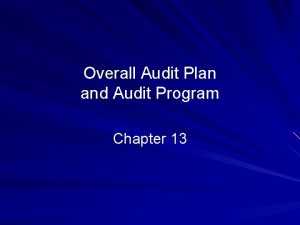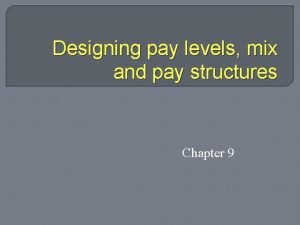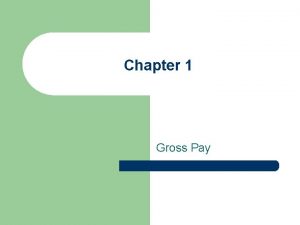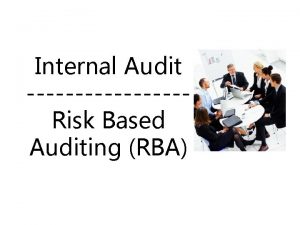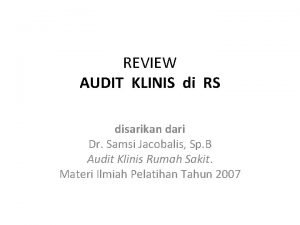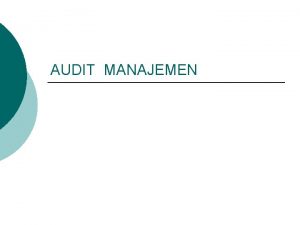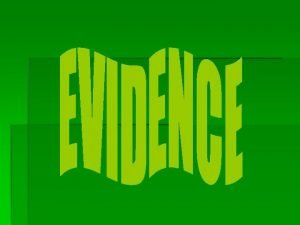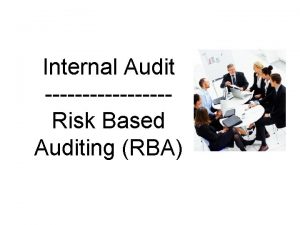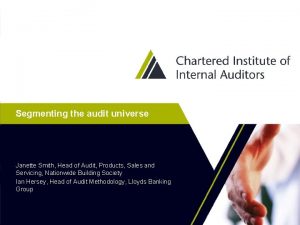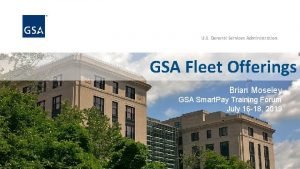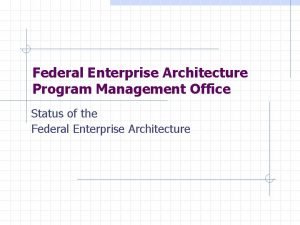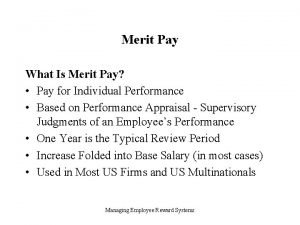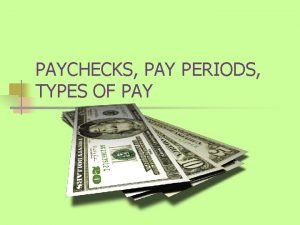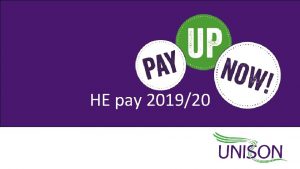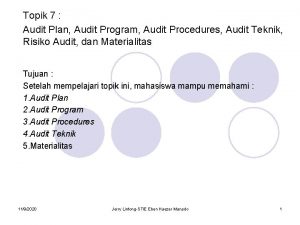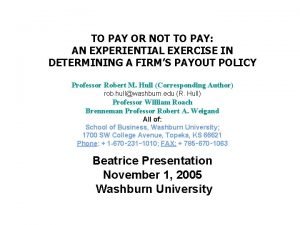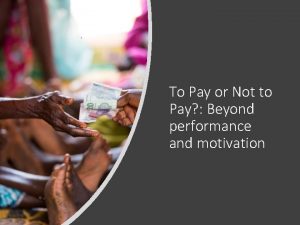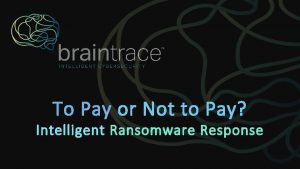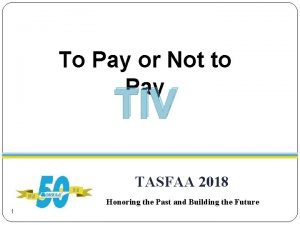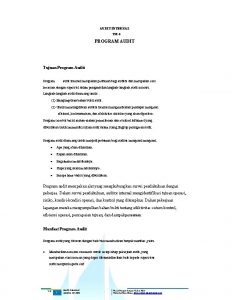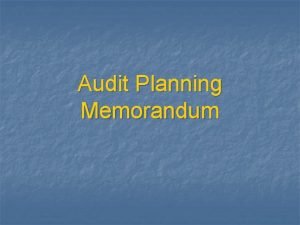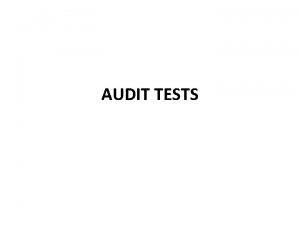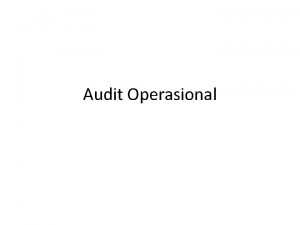Do Not Pay Program Update 2013 Federal Audit


















- Slides: 18

Do Not Pay Program Update 2013 Federal Audit Executive Council Annual Conference September 27, 2013 Tom Vannoy Program Director, Do Not Pay Debt Management Services Bureau of the Fiscal Service U. S. Department of the Treasury FAEC Annual Conference September 27, 2013 1

What is Do Not Pay? § Supports Federal agencies in their efforts to reduce the number of improper payments made through programs funded by the Federal government § Provides a single point of access for agencies to check various databases before making payments or awards in order to identify ineligible recipients and prevent fraud or errors from being made § Users access data through the Do Not Pay portal § Treasury is in the process of integrating pre-payment verification against Do Not Pay data sources as part of the normal payment process FAEC Annual Conference September 27, 2013 2

Improper Payments § “Improper payments” occur when: § Funds go to the wrong recipient § The right recipient receives the incorrect amount of funds (including overpayments and underpayments) § Documentation is not available to support a payment, or § The recipient uses funds in an improper manner. § $108 billion in FY 2012 § Not all improper payments represent a loss to the Government § Causes of improper payments vary § Documentation and administrative errors § Authentication and medical necessity errors § Verification errors FAEC Annual Conference September 27, 2013 3

Improper Payments Improper payments as “actual loss to the government” $B Description Methodology FY 12 Improper Payments $108 OMB estimate of improper payments § Agencies follow OMB guidelines for classifying improper payments in three categories: verification, administration, and authentication Underpayments $10 Payee was entitled to a larger payment ▪ Agencies report underpayment amounts separately in their Agency Financial Reports (AFR) Payment lacked correct documentation, but payee was entitled to the full amount paid ▪ AFRs and interviews indicate an agency error in documenting a claimant request, but no substantive error Assumed only 10% of this category is actual loss to the government unless explicitly specified Portion of overpayments that is correct ▪ Agency financial reports and interviews indicate that eligibility or policy to award payment was unclear Assumed 50% actual loss to the government unless explicitly specified Fraud not counted in existing improper payment accounting ▪ ▪ Total dollar loss § Actual loss to the government is the summation of ‒ Payments where the full amount was lost to the government ‒ The ineligible portion of overpayments ‒ Uncounted fraud Correct payment w/o documentation Eligible portion of overpayment 1 Uncounted fraud Loss to the government $26 $15 $7 $64 ▪ Fraud rate of total outlays based on research and interviews NOTE: Figure does not include uncounted fraud from nonhigh-risk programs (e. g. , tax fraud); actual figure across government likely to be much higher 1 Assumes 50% of overpayments ($19, 051) should have actually been paid FAEC Annual Conference September 27, 2013 4

Improper Payment Initiative Executive Order Reducing Improper Payments and Eliminating Waste in Federal Programs November 2009 The purpose of this order was to reduce improper payments by intensifying efforts to eliminate payment error, waste, fraud, and abuse in the major programs administered by the Federal Government, while continuing to ensure that Federal programs serve and provide access to their intended beneficiaries. Presidential Memorandum. Enhancing Payment Accuracy Through a “Do Not Pay List” June 2010 Directed agencies to review current pre- payment and pre-award procedures and ensure that a thorough review of available databases with relevant information on eligibility occurs before the release of any Federal funds, to the extent permitted by law. At a minimum, agencies shall, before payment and award, check the following existing databases to verify eligibility: § Credit Alert Verification Reporting System § Death Master File § Debt Check Database § List of Excluded Individuals/Entities § System for Award Management / Excluded Parties List System Development of the Do Not Pay Business Center April 2011 The Treasury’s Bureau of the Fiscal Service partnered with the Saint Louis and Kansas City Federal Reserve Banks as Treasury’s Fiscal Agent, to develop the Do Not Pay Business Center as part of the “Do Not Pay” solution. Do Not Pay was available in November 2011. FAEC Annual Conference September 27, 2013 Memorandum For Heads of Executive Departments and Agencies – Reducing Improper Payments Through the “Do Not Pay List” April 2012 Directed Executive Agencies to take immediate steps to use the centralized solutions that are already in place for pre-payment eligibility review. The memorandum requires the Chief Financial Officer of each agency (or the accountable official for improper payments and program integrity, under Executive Order 13520) to submit to OMB a plan for using centralized solutions. 5

Improper Payment Initiative - continued Improper Payments Elimination and Recovery Improvement Act of 2012 (IPERIA), Public Law 112 -248 Enacted January 10, 2013 Reinforced the Administration’s ongoing efforts, IPERIA requires Federal executive agencies to review, as appropriate and before issuance, all payments and awards for all programs through a Do Not Pay Working System by June 1, 2013. IPERIA requires the Office of Management and Budget (OMB) to develop a Database Integration Plan for the Do Not Pay Initiative focusing on the following elements: § Providing agency access to the Do Not Pay Initiative § Improving date use agreements to facilitate data access for the purposes of program integrity; and § Including other databases in the Do Not Pay Initiative Database Integration Plan for the Do Not Pay Initiative May 2013 OMB pursued a phased approach in implementing the databases that agencies will use to check, as appropriate, all awards and payments. The first phase focuses on two publicly available databases, Death Master File (DMF) of the Social Security Administration and General Services Administration’s (GSA) System for Award Management (SAM) data (formerly the Excluded Parties List System (EPLS). IPERIA allows the expansion of databases. The Fiscal Year 2014 President’s Budget included key proposals to strengthen Do Not Pay by expanding access to multiple statutorily restricted databases. FAEC Annual Conference September 27, 2013 Memorandum For Heads of Executive Departments and Agencies – Protecting Privacy while Reducing Improper Payments with the “Do Not Pay Initiative” August 2013 This memorandum sets forth implementation guidance for the DNP Initiative to help ensure that the Federal Government’s efforts to reduce improper payments comply with privacy laws and policies. It builds on previous OMB guidance. Although this Memorandum creates new policy requirements, it does not extend the legal requirements of the Privacy Act to information or activities that would not otherwise be covered under the statue. The DNP-specific standards and procedures do not apply to other efforts to combat improper payments or matching programs that are not part of the DNP initiative 6

Roles & Responsibilities OMB § Establish governmentwide improper payments policy § Provide IPERIA and Privacy Act guidance § § § Dept of the Treasury Program Agencies § Manage Do Not Pay program, including integration into payment process § Determine applicant, contractor, grantee, and payee eligibility for awards and payments § § Work with senior agency leadership to ensure compliance Engage and support agencies in their efforts to implement Do Not Pay § Support efforts to make additional data sources available Provide analytics associated with payment/data source matching Review Do Not Pay match results and take action on payments and awards identified as improper § § Incorporate Do Not Pay into improper payments program Evaluate, coordinate, and submit legislative proposals Ensure compliance with relevant laws, including privacy and disclosure laws FAEC Annual Conference September 27, 2013 7

Do Not Pay Objectives § Strategic: § Provide Federally-funded programs and law enforcement agencies with, centrally-provided IPERIAmandated & agency-driven, timely, accurate & actionable information & analysis to support the prevention, reduction, and recovery of improper payments FAEC Annual Conference September 27, 2013 § Tactical: § Identify potentially improper payments by comparing agency payments to lists of ineligible recipients § Provide agencies with: § analytical insights about payments to potentially ineligible recipients to help them identify systemic sources of improper payment and/or potential fraud § information about patterns of improper payments to help them identify systemic sources of improper payment and/or potential fraud § analytical insights about the sources of future improper payments 8

Business Process Integration Pre-Payment Pre-Award • Verify Federal Award Eligibility User submits data for entities under consideration & receives matching results. • Re-Verify or Monitor Program Eligibility for Payments • Research Matches Post-Payment • Trending & Analytics • Reporting • Corrective Action User submits data for entities receiving payments or being monitored & receives matching results. Online, batch matching, and continuous monitoring are supported within the Portal. Data Analytics Services staff analyzes the data and trends and provide reports to support agency investigation and recovery efforts. FAEC Annual Conference September 27, 2013 9

Do Not Pay Business Center Portal Data Analytics Services Provides users with an internet-based, one stop shop for their data needs. Agencies can select the best searching methods to incorporated into their business processes. Provides agencies with additional customized analysis to combat improper payments. General Statistics Trending – Observing how data changes over time. Online Single Search Deep Dive Analysis – Performing further research on specific groups, individuals, or entities. Batch Matching Agency Specific Analysis Continuous Monitoring Payment File Analysis Agency Support Center Supports users for both services in all aspects of the process. Also, provides personalized training and portal demonstrations. FAEC Annual Conference September 27, 2013 10

Portal Current Data Sources Current Data Source Social Security Administration’s Death Master File (DMF) (public version) Health and Human Service Office of Inspector General’s List of Excluded Individuals/Entities (LEIE) (public version) Summary Description General Services Administration’s Central Contractor Registry (CCR) A listing of deaths that have been reported by the Social Security Administration Individuals and entities currently excluded from participation in federal healthcare programs, such as Medicare, Medicaid, and State Children’s Health Insurance Program (SCHIP) Parties excluded from Federal procurements: individuals and firms excluded from receiving new federal contracts; and individuals and companies owned or controlled by targeted countries; and individuals, groups, and entities, such as terrorists and narcotics traffickers Primary vendor database of both current and potential government vendors eligible for Federal procurements Department of Treasury’s Office of Foreign Assets Control’s list (OFAC) Individuals/companies who US citizens are not allowed to pay Equifax’s The Work Number® (TWN) Employment and income information for individuals Bureau of the Fiscal Service’s Debt. Check Delinquent child support and non-tax debt owed to the federal government General Service Administration‘s Excluded Party List System (EPLS) (public and private versions) FAEC Annual Conference September 27, 2013 11

Legislation Treasury is Monitoring Proposed New/Improved Data Sources § § § Full Death Master File Prisoner Update Processing System (PUPS) National Directory of New Hires (NDNH) FAEC Annual Conference September 27, 2013 12

Data Sources Under Evaluation § Social Security Administration’s Death Master File (DMF) (private version) provides information about all deaths that have been reported to the Social Security Administration, including deaths reported by 32 states. Access to this database is restricted by statute. The FY 14 President’s Budget contains a legislative proposal authorizing access for Do Not Pay and improper payment purposes. § Department of Housing and Urban Development’s (HUD) Credit Alert Verification Reporting System (CAIVRS) provides information about outstanding loans, loans in default, or judgments for the Departments of Housing and Urban Development, Veterans Affairs, Education, Agriculture, and Justice and the Small Business Administration. The records are subject to the Privacy Act, and Do Not Pay is working with CAIVRS agencies to ensure compliance. § Department of Health and Human Services Office of Inspector General’s List of Excluded Individuals/Entities (LEIE) (private version) provides unique identifiers (taxpayer identifying numbers) that are not included in the public version. The records are subject to the Privacy Act and Do Not Pay is working with HHS to ensure compliance. § Department of Health and Human Services’ National Directory of New Hires (NDNH) provides quarterly wage information reported by employers to State Workforce Agencies and Employee Withholding Allowance Certificates (Internal Revenue Service Form W-4) for new employees. Access to this database is restricted by statute. The FY 14 President’s Budget contains a legislative proposal authorizing access for Do Not Pay for agencies with existing access to NDNH. § Social Security Administration’s Prisoner Update Processing Systems (PUPS) provides information about Federal, state and local prisoners. Access to this database is restricted by statute. The FY 14 President’s Budget contains a legislative proposal authorizing access for Do Not Pay and improper payment purposes. FAEC Annual Conference September 27, 2013 13

DNP Vision for Supporting State Administered Programs How else we think we can help: we feel cross matching is the most efficient way for us to help prevent improper payments Cross matching is defined as running one state’s list of beneficiaries, or potential beneficiaries, against one or more other states records to identify duplicates. Step 1: Ensure we have the proper authority to do cross matching Step 2: Identify key state administered Federally funded programs where cross matching helps Step 3: Enable States to perform online, batch or continuous monitoring cross matching FAEC Annual Conference September 27, 2013 14

Integration into the Payment Stream Phase 1: § At the end of May, Treasury began sending monthly Do Not Pay prepayment risk reports to agencies to facilitate compliance with IPERIA. Each report contains the match results of a comparison of an agency’s payment files to the public versions of two databases: § Social Security Administration’s Death Master File (DMF) § System for Award Management (SAM, which includes the former Excluded Parties List) § Agencies need to: § Review matches to determine which represent “improper payments” § Take appropriate action and report results § Provide feedback to Treasury on how to better filter hits results to provide more actionable reports. FAEC Annual Conference September 27, 2013 15

Integration into the Payment Stream Phase 2: § Beginning in October 2013, Treasury will provide pre-payment information to agencies using real time payment files submitted to Treasury through the Payment Application Modernization (PAM) format § Results will be viewable through the Do Not Pay portal § Treasury will continue to send monthly pre-payment risk reports § Agencies continue to review matches, take action, and report results Phase 3: § In June 2014, Treasury will stop or flag payments deemed improper before they are made based on agency direction FAEC Annual Conference September 27, 2013 16

Agency Adjudication Process Analysis on the DNP file completed with conclusive, probable and possible matches Based on information learned, determine if payment should be paid. 1 8 Ensure alignment with existing process and mission of the organization 7 2 Notification email sent to log in and view results in the DNP Portal Uncertainty about how to proceed begins 6 3 Investigate further, confirm matches & document decision Prioritize the critical matches for your agency 5 Apply the rules that are applicable to each of the data sources FAEC Annual Conference September 27, 2013 4 Research the internal business rules that apply to your data 17

Learn More About Do Not Pay Get More Information Want to Learn More? Reach out to the Agency Support Center to find the services that best fit your agency’s needs. Sign up for our mailing list to receive updates on new functionality and data sources or to schedule a demo. Contact the Agency Support Center or visit us at www. donotpay. treas. gov DNP Program Director: Tom Vannoy Phone: 202 -874 -6185 E-mail: Thomas. Vannoy@bpd. treas. gov 1 -855 -837 -4391 donotpay@stls. frb. org FAEC Annual Conference September 27, 2013 18
 Recovery techniques based on immediate update
Recovery techniques based on immediate update Overall audit plan
Overall audit plan How much did wanda pay in taxes this pay period
How much did wanda pay in taxes this pay period Pay level and pay mix
Pay level and pay mix Short term incentive
Short term incentive Chapter 1 gross pay answers
Chapter 1 gross pay answers Sudden and violent but brief; fitful; intermittent
Sudden and violent but brief; fitful; intermittent Perbedaan audit konvensional dengan audit berbasis risiko
Perbedaan audit konvensional dengan audit berbasis risiko Clinical meeting
Clinical meeting Beda audit medis dan audit klinis
Beda audit medis dan audit klinis Penyelesaian audit dan tanggung jawab pasca audit
Penyelesaian audit dan tanggung jawab pasca audit Kerangka kerja audit manajemen
Kerangka kerja audit manajemen Prosedur audit bottom-up dan audit top-down!
Prosedur audit bottom-up dan audit top-down! Auditor definition
Auditor definition Perbedaan audit konvensional dengan audit berbasis risiko
Perbedaan audit konvensional dengan audit berbasis risiko The word audit derived from the latin word
The word audit derived from the latin word Audit universe vs audit plan
Audit universe vs audit plan Gsa drive-thru login
Gsa drive-thru login Federal enterprise architecture business reference model
Federal enterprise architecture business reference model

